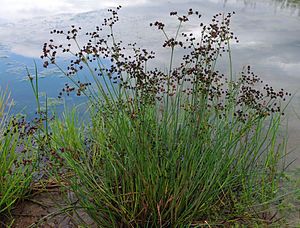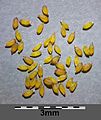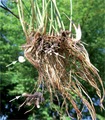Limb bulrush
| Limb bulrush | ||||||||||||
|---|---|---|---|---|---|---|---|---|---|---|---|---|

Joint rush ( Juncus articulatus ) |
||||||||||||
| Systematics | ||||||||||||
|
||||||||||||
| Scientific name | ||||||||||||
| Juncus articulatus | ||||||||||||
| L. |
The articulated rush ( Juncus articulatus ), also called glossy rush , belongs to the rush family (Juncaceae). It owes the name Glieder-Rush to the cross-chambered pith inside its leaves.
description
The perennial, wintering green hemicryptophyte reaches heights of growth between 15 and 70 centimeters. With its creeping rhizome and short runners, it forms loose lawns. The characteristic rush-shaped, pointed leaves are rounded or compressed in cross-section. They are hollow on the inside, enclosed by transverse walls and filled with a cobweb-like pith. The auricles of the leaf sheaths are long and membranous. The stems of the common limb rush are usually arching, while those of the beach limb rush are rigidly upright.
The inflorescence is about 10 centimeters high, upright spiral with obliquely upright side branches and hemispherical heads. These are about 5 millimeters wide. With the common rush they consist of five to thirty, with the beach rush they consist of four to six individual flowers . The tepals are red-brown, of equal length and lanceolate. They are between 2 and a maximum of 4 millimeters long. The inside is a little bit skin-fringed. The pointed, egg-shaped capsule is glossy black-brown and as long or longer than the petals. They contain few lemon-shaped seeds.
The flowering period of the limb bulrush extends from July to October.
The chromosome number of the species is 2n = 80.
ecology
The flowers are pollinated by the wind. The diaspores are also spread by the wind or by adhering to the fur or feathers of animals. As a half-light to full-light plant, the plant does not tolerate shading. Your ecological focus is on permanently well-soaked, air and nitrogen-poor soils. The pulp of the leaves serves as aeration tissue ( aerenchyma ) so that the plant is adequately supplied with oxygen even in the air-poor soil .
Root of the limb bulrush with galls produced by the fungus Entorrhiza casparyana , a species of Entorrhiza
Distribution and location
The bulrush is common throughout Europe, Asia, North America and North Africa. It was also introduced to New Zealand and Australia. Their height distribution reaches up to 2000 meters. In the Allgäu Alps in Vorarlberg between Hochkrumbach and Haldenwanger Eck it rises up to 1750 m above sea level. The marsh plant (helophyte) grows in swamps , moors , wet meadows and at the edges of water bodies. In Central Europe it occurs mainly in Scheuchzerio-Caricetea-fuscae societies, but also in societies of the associations Calthion, Agropyro-Rumicion or Nanocyperion.
Systematics
The limb rush was first published in 1753 by Carl von Linné in Species Plantarum as Juncus articulatus . The Latin articulátus, -a, -um means "structured".
One can distinguish the following subspecies:
- Juncus articulatus subsp. articulatus : It occurs in the temperate zones of the northern hemisphere.
- Juncus articulatus subsp. limosus (Vorosch.) Vorosch. : It occurs from Siberia to Japan.
There are differentiated by K. reefs in Germany two subspecies: the ordinary members-rush ( Juncus articulatus subsp. Articulatus ) and the beach-members-rush ( Juncus articulatus subsp. Litoralis (Patze, EHF Meyer & Elkan) Lemke nom inval.. ). They differ mainly in the shape of the inflorescences and the length of the tepals . The last-mentioned subspecies is however from Kirschner et al. and not recognized by others. In contrast, another subspecies Juncus articulatus subsp. limosus (Vorosch.) Vorosch. called, which represents the species in East Asia.
swell
literature
- Jürke Grau , Bruno P. Kremer, Bodo M. Möseler, Gerhard Rambold, Dagmar Triebel: Grasses. Sweet grasses, sour grasses, rushes and grass-like families in Europe (= Steinbach's natural guide ). New, edit. Special edition edition. Mosaik, Munich 1996, ISBN 3-576-10702-9 .
- Erich Oberdorfer : Plant-sociological excursion flora . With the collaboration of Theo Müller. 7th, revised and expanded edition. Eugen Ulmer, Stuttgart (Hohenheim) 1994, ISBN 3-8252-1828-7 .
Individual evidence
- ↑ a b Erich Oberdorfer : Plant-sociological excursion flora for Germany and neighboring areas . 8th edition. Stuttgart, Verlag Eugen Ulmer, 2001. ISBN 3-8001-3131-5 . Page 150.
- ↑ Erhard Dörr, Wolfgang Lippert : Flora of the Allgäu and its surroundings. Volume 1, IHW, Eching 2001, ISBN 3-930167-50-6 , p. 301.
- ↑ Carl von Linné: Species Plantarum. Volume 1, Lars Salvius, Stockholm 1753, p. 327, digitized
- ↑ a b c d Rafaël Govaerts (Ed.): Juncus articulatus. In: World Checklist of Selected Plant Families (WCSP) - The Board of Trustees of the Royal Botanic Gardens, Kew . Retrieved October 8, 2016.
- ^ Karl Kiffe: Juncaceae. In: Henning Haeupler, Thomas Muer: picture atlas of fern and flowering plants in Germany . Ed .: Federal Agency for Nature Conservation (= The fern and flowering plants of Germany . Volume 2 ). Eugen Ulmer, Stuttgart (Hohenheim) 2000, ISBN 3-8001-3364-4 , pp. 590 .
- ↑ Karl Peter Buttler , Michael Thieme & collaborators: Florenliste von Deutschland - Vascular Plants, Version 5. Frankfurt am Main, July 2013, published on the Internet , accessed on March 17, 2014.
Web links
- Limb bulrush. In: FloraWeb.de.
- Limb bulrush . In: BiolFlor, the database of biological-ecological characteristics of the flora of Germany.
- Profile and distribution map for Bavaria . In: Botanical Information Hub of Bavaria .
- Juncus articulatus L. In: Info Flora , the national data and information center for Swiss flora .
- Distribution in the northern hemisphere from: Eric Hultén, Magnus Fries: Atlas of North European vascular plants. 1986, ISBN 3-87429-263-0 at Den virtuella floran. (Swedish)
- Thomas Meyer: Data sheet with identification key and photos at Flora-de: Flora von Deutschland (old name of the website: Flowers in Swabia )
- Juncus articulatus inthe IUCN 2013 Red List of Threatened Species . Posted by: Allen, D., 2010. Retrieved April 11, 2014.







